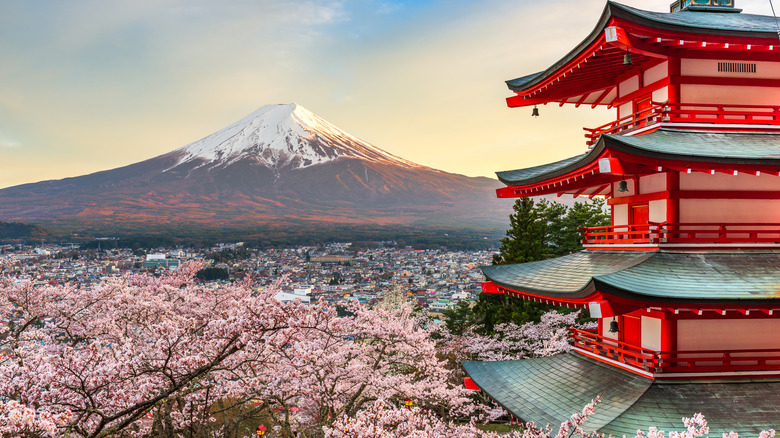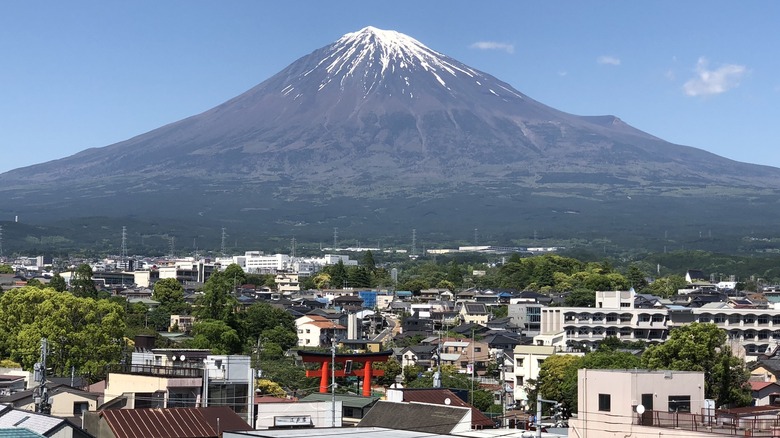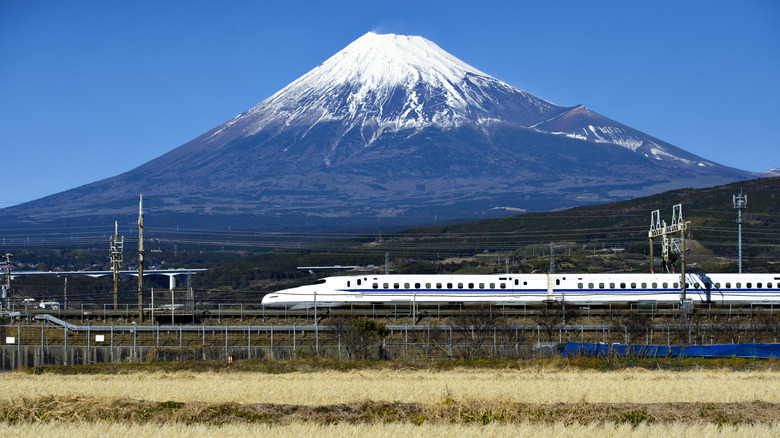This Popular Mountain Is One Of The Most Filmed Locations In Asia
Though it's a common sight in movies and people's vacation photos of Japan, visual depictions of Mount Fuji are nothing new. Just ask the ukiyo-e artist Hokusai, who famously portrayed the mountain in his 17th-century woodblock print series, "Thirty-Six Views of Mt. Fuji." With its pristine, snow-capped volcanic cone, you can even see the mountain on the back of Japan's currency. Since 2004, the 1,000 yen bill has shown another well-known view of Mount Fuji across Lake Motosuko in Yamanashi Prefecture.
Coincidentally — or perhaps not so coincidentally — you'll also pay 1,000 yen as the standard conservation donation to climb Mount Fuji. The climbing season lasts from early July to early September in Yamanashi and neighboring Shizuoka Prefecture. The donation system has been in effect ever since UNESCO designated Mount Fuji a World Heritage Site and a "sacred place and source of artistic inspiration." From the 20th century onward, that artistic inspiration has extended to many movies featuring the 12,388-foot mountain.
A 2021 NetCredit analysis of movie credits on the Internet Movie Database (IMDb) determined that Mount Fuji is Asia's most-filmed location. However, since IMDb's lists of film appearances are user-generated, they're not an exact science, but more of a starting point to refresh the moviegoer's memory. What's clear is that Mount Fuji shows up in a long list of old Japanese films and even some recent Hollywood hits. The more adventurous viewer could find some real-life travel inspiration in those movies — and you don't even have to be a mountain climber for that.
Mount Fuji in the movies
One of the earliest movies to show Mount Fuji was the 1934 Japanese silent film "Street Without End." However, the mountain's recurring appearance in the "Godzilla" movie series is probably better known to Western audiences. To this day, you can still find many of the real-life landmarks demolished by Godzilla in Japan. Mount Fuji usually survives destruction, though it's served as a scenic backdrop for giant monsters in films like "Pacific Rim Uprising," "Destroy All Monsters," and "Godzilla vs. Mechagodzilla II." In "Godzilla vs. Mothra," the mountain appears without snow. Mount Fuji's first light snowcap usually arrives in early October.
In 1956, the mountain graced the Oscar-winning film adaptation of Jules Verne's "Around the World in 80 Days." "Throne of Blood," filmmaker Akira Kurosawa's 1957 adaptation of Shakespeare's "Macbeth," achieved its unique look by shooting on the misty slopes and volcanic soil of the real Mount Fuji. If you climb the mountain, you might experience the same sense of landscape as clouds roll in.
In the 21st century, Mount Fuji has continued to appear in numerous Hollywood films, though not all have been shot on location in Japan. Another Oscar winner, "Lost in Translation," is one that really did shoot here. The Tokyo luxury hotel from that film will put you right in your favorite movie setting. Beginning around the 57:33 mark, there's a minute-long shot of Mount Fuji looming large as Bill Murray's character plays golf at the Kawaguchiko Country Club, southwest of Tokyo.
Bullet train views of Mount Fuji
During the opening credits of "The Sea of Trees," Matthew McConaughey's protagonist looks out the window around the 4:40 mark, and we see the classic image of the bullet train passing in front of Mount Fuji. You can see similar views of the mountain juxtaposed with trains in the city of Fuji, near Yoshiwara Station or Fujikawa Station on JR-Central's Tokaido Line. Sit on the right side of the bullet train if you're coming from Tokyo and want to see the mountain from your own window near Shin-Fuji Station.
Most of "The Sea of Trees" was actually filmed in Massachusetts, where F. Gilbert Hills State Forest substituted for the forest of Aokigahara, on Mount Fuji's northwestern side. Likewise, despite showing the real train bridge in Akihabara, Tokyo, the Brad Pitt movie "Bullet Train" was mostly shot in California at Sony Pictures Studios. However, you can see a night view of Mount Fuji in the film at about 1:15:55.
In "The Matrix Resurrections," it's Keanu Reeves who rides the bullet train toward Mount Fuji around the 43:26 mark. He's inside the Matrix, though, where nothing is real and the mountain is merely simulated in a view with picture-perfect cherry blossoms. One of the most popular places for seeing Mount Fuji during the real cherry blossom season is Chureito Pagoda in Fujiyoshida. The lookout over the pagoda, surrounded by hundreds of cherry trees, comes alive with blooming pink blossoms in mid-April.


